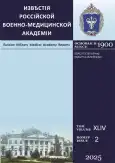Comparison of Primary Disease Incidence Among Students of Pre-University Educational Schools of the Russian Ministry of Defence and Russian Adolescents
- Authors: Soldatov I.K.1,2, Evdokimov V.I.3, Arsentiev V.G.1, Makiev R.G.1, Fedorov O.A.1
-
Affiliations:
- Military Medical Academy
- Saint Petersburg State University
- Nikiforov Russian Center of Emergency and Radiation Medicine, EMERCOM of Russia
- Issue: Vol 44, No 2 (2025)
- Pages: 159-166
- Section: Original articles
- URL: https://bakhtiniada.ru/RMMArep/article/view/310900
- DOI: https://doi.org/10.17816/rmmar632383
- EDN: https://elibrary.ru/HXASRV
- ID: 310900
Cite item
Abstract
Background: In 33 educational schools of the Russian Ministry of Defense, approximately 18,000 students are enrolled in programs preparing them for military or other public service functions. These programs are focused on the development of an active personality, innovative thinking, physical training, and the improvement of the body’s functional reserves.
AIM: of this study was to compare the primary incidence trends and patterns categorized by the International Classification of Diseases, 10th revision, among students of pre-university educational schools of the Russian Ministry of Defense and general population of Russian adolescents over a 12-year period (2010–2022).
METHODS: The analysis included primary disease incidence data submitted with 13K/MED reports. Primary disease codes were matched with classes of the 10th revision of the International Statistical Classification of Diseases and Related Health Problems. The incidence rates were calculated per 1000 students (%). The primary disease incidence rates were compared between students and general population of adolescents aged 15–17 years. The long-term average annual rate was determined based on total absolute values over the 12-year period. The annual average rates alongside with arithmetic means and their standard errors (M ± m) were calculated for the analysis of similarities (differences). The trends were assessed by analyzing time series and calculating a second-order polynomial trendline.
RESULTS: Among students, the long-term average annual and average annual rates were 2694.3% and 2709.0 ± 77.1%, respectively, in 2010–2022. For Russian adolescents, lower values were observed, i.e. 1361.2% and 1380.0 ± 19.9%, respectively (p < 0.001). We assume that higher rates of primary disease incidence among students were attributed to higher rates of disease detection, more accessible qualified and high-tech medical care, and personalized accountability of all cases, including those of mild or moderate severity, which are associated with home treatment and are not reported by regional healthcare facilities of the Russian Ministry of Health. Primary incidence rates were calculated for main classes of diseases reported in students and Russian adolescents.
CONCLUSION: The early detection, prevention, timely treatment and rehabilitation of main classes of diseases can significantly reduce the primary disease incidence among students of pre-university educational schools of the Russian Ministry of Defense and Russian adolescents aged 15–17 years.
Full Text
##article.viewOnOriginalSite##About the authors
Ivan K. Soldatov
Military Medical Academy; Saint Petersburg State University
Email: ivan-soldatov@mail.ru
ORCID iD: 0000-0001-8740-9092
SPIN-code: 1503-1278
MD, Cand. Sci. (Medicine)
Russian Federation, 6, Akademika Lebedeva str., Saint Petersburg, 194044; Saint PetersburgVladimir I. Evdokimov
Nikiforov Russian Center of Emergency and Radiation Medicine, EMERCOM of Russia
Email: 9334616@mail.ru
ORCID iD: 0000-0002-0771-2102
SPIN-code: 1692-4593
MD, Dr. Sci. (Medicine), Professor
Russian Federation, Saint PetersburgVadim G. Arsentiev
Military Medical Academy
Author for correspondence.
Email: vmeda-nio@mil.ru
ORCID iD: 0000-0002-3135-0412
SPIN-code: 1186-9388
MD, Dr. Sci. (Medicine), Professor
Russian Federation, 6, Akademika Lebedeva str., Saint Petersburg, 194044Ruslan G. Makiev
Military Medical Academy
Email: vmeda-nio@mil.ru
ORCID iD: 0000-0002-2180-6885
SPIN-code: 4703-5573
MD, Dr. Sci. (Medicine), Associate Professor
Russian Federation, 6, Akademika Lebedeva str., Saint Petersburg, 194044Oleg A. Fedorov
Military Medical Academy
Email: vmeda-nio@mil.ru
ORCID iD: 0009-0006-1152-8910
SPIN-code: 1793-7697
MD, Cand. Sci. (Medicine), Associate Professor
Russian Federation, 6, Akademika Lebedeva str., Saint Petersburg, 194044References
- Belyakova IS, Tarasochkina DS. Features of incidence in cadets Astrakhan region. Chronos. 2022;7(3):4–7. doi: 10.52013/2658-7556-65-3-1 EDN: PBYOXP
- Maklakova OA, Vandysheva AYu, Tolmacheva OG, Eisfeld DA. Pathology features of musculoskeletal system in children of innovativeeducational institution. Preventive and clinical medicine. 2020;(3):21–25. EDN: DEAARD
- Eisfeld DA, Shtina IE, Maklakova OA, Valina SL. Assessment of functional reserves of the cardiorespiratory system in students of cadet corps. Zdorov’e Naseleniya i Sreda Obitaniya. 2021;(6):65–70. doi: 10.35627/2219-5238/2021-339-6-65-70 EDN: OWIQXT
- Barazenko KV, Prokopenko AA, Shamrey VK, Kolchev AI. Features of mental health in students of cadet corps. Bulletin of the Russian Military Medical Academy. 2007;18(2):62–65. EDN: KWZOZX
- Voronina YuS, Sakharov AV. Manifestations of suicide risk and aggression in the structure of neurotic disorders in cadets of the Suvorov military school. Siberian herald of psychiatry and addiction psychiatry. 2021;(4): 37–46. doi: 10.26617/1810-3111-2021-4(113)-37-46 EDN: BOIHSB
- Sibiryakova NV. Dynamics and features of psychological adaptation of cadets to the educational process. Chronos. 2022;65(3):8–12. doi: 10.52013/2658-7556-65-3-2 EDN: UFQENG
- Balashova LA, Karaseva NV, Zhmakin IA. Osobennosti okazaniya i nekotorye rezul’taty lechebno-profilakticheskoi deyatel’nosti v FGKOU “Tverskoe suvorovskoe voennoe uchilishche Ministerstva oborony” Rossiiskoi Federatsii. Tverskoi meditsinskii zhurnal. 2020;(2):132–136. EDN: HIUHZC
- Ashvits IV. O nekotorykh pokazatelyakh sostoyaniya zdorov’ya vospitannikov uchebnogo zavedeniya nachal’nogo voennogo obrazovaniya (na primere Omskogo kadetskogo korpusa). Omsk scientific bulletin. 2006;(9): 301–303. EDN: ZJBBZX
- Ukazaniya po vedeniyu meditsinskogo ucheta i otchetnosti v Vooruzhennykh silakh Rossiiskoi Federatsii na mirnoe vremya. Moscow; 2001. 40 p. (In Russ.)
- Afanasyev VN. Time series analysis and forecasting. Saratov: IPR MEDIA; 2020. 286 p. (In Russ.)
Supplementary files









